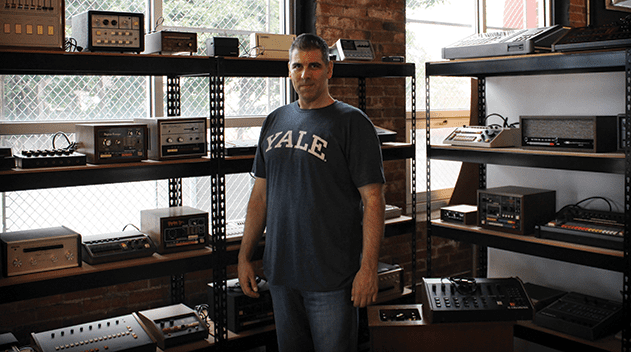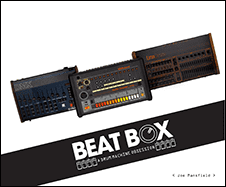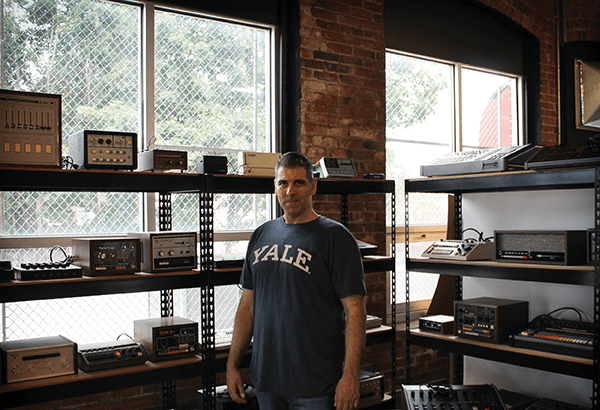This beautifully produced coffee table book documents the author’s life-long obsession with drum machines, but leaves Greg Scarth wanting more.

The author with a small part of his collection
Joe Mansfield is a hip-hop producer best known for ED OG’s Bohannon-sampling ‘I Got To Have It’, co-owner of reissue specialists Get On Down and a self-confessed drum machine obsessive. In Beat Box he documents his extensive collection, chronicling the evolution of the drum machine from the 1959 Wurlitzer Side Man through to Sequential Circuits’ 1984 Studio 440.
 There are units here obscure enough to tease even the most knowledgeable drum machine collector. Take the Kenwood KR-6170, a baffling early-70s AM/FM receiver with built-in ‘electronic rhythm composer’ and reverb unit. Was this an early attempt at home recording technology, or a misguided effort to push home hi-fi into uncharted territory?
There are units here obscure enough to tease even the most knowledgeable drum machine collector. Take the Kenwood KR-6170, a baffling early-70s AM/FM receiver with built-in ‘electronic rhythm composer’ and reverb unit. Was this an early attempt at home recording technology, or a misguided effort to push home hi-fi into uncharted territory?
How about Roland’s PB-300 Rhythm Plus, the company’s last analogue drum machine? Produced in 1984, it featured a very early implementation of MIDI which allowed it to trigger basslines, chords and arpeggios in conjunction with the PR-800 Digital Piano Recorder (a rudimentary sequencer). Why wasn’t it a commercial success, given that it apparently simplified the sequencing process which has formed the basis of electronic music ever since?
Reading Beat Box raises these questions but leaves them unanswered. The majority of the drum machines featured in the book are explained with just a short paragraph of text – just a couple of sentences in some cases – placing the emphasis on the excellent photographs by Gary Land. Visually, the book is beautifully produced, but in places it feels unsatisfying thanks to the brevity of the accompanying text.
Given Mansfield’s obvious passion for the subject, it’s ironic that it’s the introduction – written by Dave Tompkins, author of 2010’s exceptional history of the vocoder, How To Wreck A Nice Beach – which makes the best attempt to explain the unique appeal of the drum machine.
“In 1984, drum machines were often heard but rarely seen,” Tompkins writes, explaining the impact of this otherworldly instrument when it broke through to the mainstream. “That’s why this book exists. Back then, there was no object to place with the sound, other than the records themselves. So we took measures. When T La Rock namedropped Drumulator in a song, the device became his speech mechanism. It sounded like the invention of a word-happy brain. On MCA and Burzootie’s Def Jam single ‘Drum Machine’, Adam Yauch rapped about the DMX and using your own personal memory chips. Confusion ensued. Personal chips? Was Burzootie the drum machine? I called up Radio Shack asking if they had any Burzooties in stock.”
Adam Yauch rapped about the DMX and using your own personal memory chips. Confusion ensued.
Tompkins’ all-too-brief introduction helps explain (from a hip-hop perspective) why and how drum machines had such a revolutionary impact on music. Elsewhere, Roger Linn is interviewed on the LM-1 and LinnDrum, Davy DMX on the Oberheim DMX, Marshall Jefferson on the 707. The interviews offer interesting anecdotal takes, if little in the way of original insight into the greater importance of drum machines in the evolution of music-making. But too often when you arrive at one of the more important units – the Boss DR-55, Linn LM-1 or Roland TR-808 – you’re greeted with a few extra pages of scanned manuals and adverts, but not a lot more in the way of explaining what makes these units so special.
It’s that sense of incompleteness which is Beat Box‘s weakness. The book isn’t presented as an exhaustive history and doesn’t make any claims to be a comprehensive account of the subject, but with Mansfield’s passion and enviable collection, Tompkins’ research skills and Land’s photography, Beat Box seems like a missed opportunity to present something much more thorough and detailed.

01.37 PM
Hi,
Thanks for the drum samples reall fantastic!
James
10.12 AM
This book is really let down by the quality of the photos – they are all very dark. For the photo of the studio440 you can only see 30% of it, the rest is black. It really is disappointing that such a nice book was printed without attention to the dark photos – a lot of text on the drum machine photos is illegible due to the darkness.